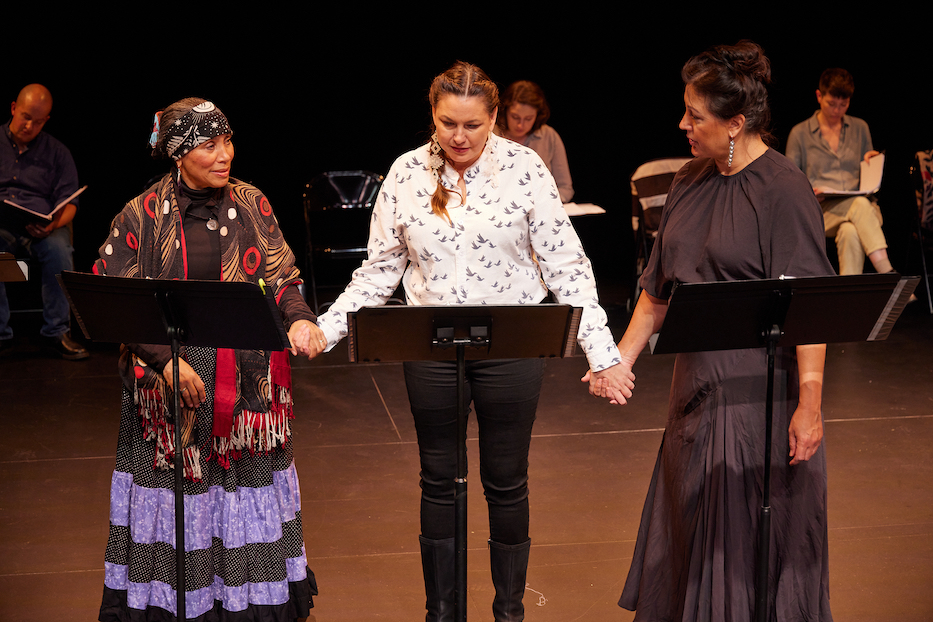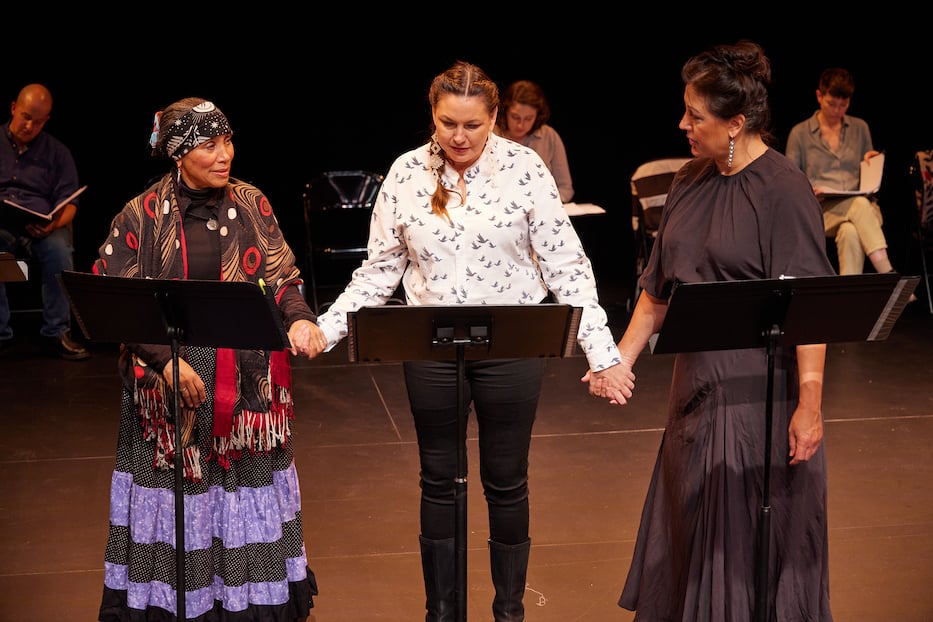
Arts & Culture | Arts & Anti-racism

Joan Henry, DeLanna Studi, and Allison Hudson Hicks in a reading of Flying Bird's Diary at Long Wharf Theatre. Jeremy Daniel Photos.
For some readers, today is one of celebration, marked by gathering with both biological and chosen family. For others, including many of the grassroots organizers and activists across the city and the state, it is a National Day of Mourning. For others still, it is both.
Today, the Arts Paper is sharing some works from the archives that explore the weight and complexity of that history. For cooking ideas and reflections on the day, we suggest previous stories from Rachel Sayet, Nadine Nelson, Sandra Harris-Pittman, and this piece from our pre-pandemic coverage of A Place to Nourish Your Health.
A reminder today and every day that what we now recognize as the State of Connecticut sits on land stewarded by the Mohegan, the Mashantucket Pequot, Eastern Pequot, Schaghticoke, Golden Hill Paugussett, Niantic, Quinnipiac, and other, once-known Algonquin speaking peoples.
At Long Wharf, "Flying Bird's Diary" Marks A Beginning
Written by Mohegan playwright Melissa Tantaquidgeon Zobel and directed by Madeline Sayet, Flying Bird's Diary the story of Fidelia Hoscott Fielding “Flying Bird,” a keeper of Mohegan culture and language whose story has, until recently, gone largely untold. As it came to Long Wharf Theatre's 222 Sargent Dr. home for a two-day reading in October, it marked an end to one physical space, and the beginning of another. Long Wharf Theatre moved officially into itinerancy when they curtain closed on the show.
Indigenous Peoples' Day Gathers Community On The Green
This year, roughly 30 people attended an observance of Indigenous Peoples’ Day on the New Haven Green, in what has become a now-annual observance (read about previous years here and here). As in previous years, it was organized by New Havener Norman Momowetu Clement, a member of the Penobscot nation and a confederate member of the Quinnipiac tribe.
From Wábi Arts To Westville, Kim Weston Grows Her Artistic Footprint
What does it mean to be Black and Native? The artist Kim Weston has been exploring that question, and New Haven is lucky that she is exploring it here.
In the past year and a half, Weston has launched and taught her first Focus Fellowship program in photography, installed her exhibition Prayer Ties at the Arts Council of Greater New Haven and work at BLOOM, and continued to build out Wábi Arts (formerly Wábi Gallery), a collaborative and educational home for artists in the heart of downtown New Haven.
In particular, she is dedicating time, space and resources to practitioners who have been and are still historically silenced, overlooked, and underrepresented.
In "Between Two Knees," Barbed Humor As Trauma Response
Humor became a necessary, gorgeous, bitter, and incisive tool in Between Two Knees, which graced the stage at the Yale Repertory Theatre earlier this year. In the first full-length play from the sketch comedy troupe The 1491s, the work explored centuries of trauma, loss, forced migration, and white violence from an Indigenous perspective, using humor as a coping mechanism. By the end, it was a unique and deeply overdue take on trauma response.
The work is written by Ryan RedCorn, Sterlin Harjo, Dallas Goldtooth, Migizi Pensoneau, and Bobby Wilson and was directed by Eric Ting.
Kinship as an Indigenous Climate Solution
In May of last year, the International Festival of Arts & Ideas presented “Listening to Earth: Indigenous Wisdom and Climate Futures.” A panel discussion hosted by Science Friday’s Diana Montano, it featured Eriel Deranger, a member of the Athabasca Chipewyan First Nation and executive director and co-founder of Indigenous Climate Action, and University of Michigan Professor Kyle Whyte. Whyte is a member of the Citizen Potawatomi Nation and professor of environment and sustainability. Read the article from reporter Adrian Huq here.
In summer 2020, six Native artists gathered virtually for “Stories, Sovereignty, and Imagining Forward” on YouTube, Vimeo and Facebook Live. The panel was part of this year’s 25th annual the International Festival of Arts & Ideas, which went completely online in the midst of the COVID-19 pandemic. Read it here.
Whose History Were We Celebrating?
In June 2020, the monument to Christopher Columbus came down in Wooster Square. The moment marked both a reckoning with history and the climax of a seven-hour standoff between Italian-American protesters, New Haven police, and New Haveners in agreement with city orders to remove the statue.
Since that day, Mayor Justin Elicker appointed and cheered on a committee tasked with finding a replacement. After years of meetings, six finalists, and several municipal hurdles, the committee selected Marc-Anthony Massaro's Indicando la via al futuro (Pointing the Way to the Future). On Tuesday, it announced a $300,000 fundraising campaign.
And yet, from the moment the committee was formed, it has not included Indigenous voices in the conversation. Wooster Square and the surrounding area are on the unceded lands of the Quinnipiac and the Wappinger Peoples. Today, we may find ourselves asking: how could the process have been different?

